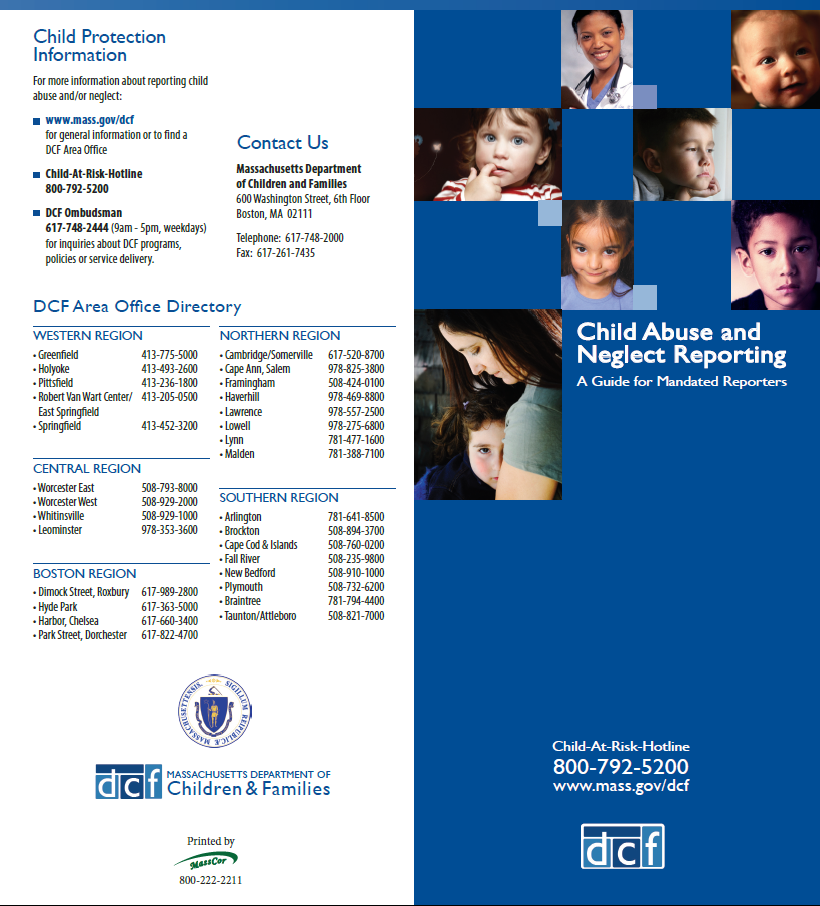Screening Toolbox: National Criminal & Sexual Abuse Background Checks
Certain organizations, such as public schools and licensed childcare programs, must also query national criminal record and fingerprint-based…
Child sexual abuse is a difficult topic. If you find yourself triggered by any of the website’s content, please stop and take the time you need to talk with someone to get support. If you need help now, please contact one of these resources today.
Home / Reporting / When to Report Abuse & Neglect
With some exceptions, a single incident or observation of suspected abuse or neglect may not necessarily trigger the need for a call to the Department of Children and Families (DCF). But even if a decision is made not to contact DCF, when an indicator is observed it should be a red flag to keep a watchful eye on the child/youth, ask fellow staff or supervisors whether they’ve noticed similar physical and/or behavioral symptoms, and keep notes about the behaviors that are causing concern. Certainly, if a pattern emerges, or the symptom becomes more pronounced or severe, a call to DCF must be made.
Most people have never filed a report with DCF, and many—especially non-professionals— who work or volunteer with children/youth may feel reluctant to do so. People may “second-guess” the situation or their own observations and remain silent because of questions about their personal liability or being sued; worry about being wrong or causing trouble to another family or to their employer; mistrust of the authorities like DCF; and uncertainty about what will happen after a report is made. That’s why it’s important that your leaders take steps to address this reluctance by “demystifying” the reporting process, by showing staff and volunteers that they will be supported in their efforts to keep children/youth safe, and by making it clear that there will be no negative consequences or repercussions for reporting—even if the report turns out to be wrong.
To increase awareness among staff and volunteers, you can keep instructional materials about child abuse, such as our chart on physical and behavioral indicators, and a one-page flow chart describing reporting, as an appendix to your Policies and Procedures, or as an attachment to your Code of Conduct. Your flow chart should include the reporting sequence to follow, the people to contact, and the numbers to call if abuse is suspected, observed, or disclosed, like in these sample charts (See Reporting Child Abuse and Neglect Sample 1 and 2 charts). Your leaders can use these materials as part of your orientation process for new hires or volunteers, and include them in annual training or professional development efforts.
Since the vast majority of abuse cases—including incidents of sexual abuse—take place at the hands of someone a child/youth knows and trusts, most of the situations that could come to the attention of your personnel would likely occur outside of your organization—in the child’s home, within their extended family, or through the family’s social network. In other cases, however, the allegation may concern a current or past employee or volunteer of your organization, or even another child or youth attending your program.
You’ll need to provide additional guidance for any allegations concerning suspected abuse occurring within your organization. Your guidance should include the process of an internal investigation, notification to parents, and a plan for public communication and response.

*See full brochure at: (https://www.mass.gov/files/documents/2017/11/30/Mandated%20Reporter%27s%20Guide_FINAL_2016.pdf)
Screening & Hiring
Certain organizations, such as public schools and licensed childcare programs, must also query national criminal record and fingerprint-based…
Policies & Procedures
Policies and Procedures are an essential backbone of your prevention strategy at your Youth-Serving Organization (YSO), providing an overarching…
Sustainability
Change Can Be a Challenge “The best-laid plans of mice and men often go awry.” So said the famed poet Robert Burns after ploughing his fields…
Training
Your organization has the opportunity to support and empower young people to feel confident, protected, and safe in their homes and communities….
Sustainability
Common Implementation Roadblocks Natural conflicts exist between strategy and culture. These conflicts—if left unaddressed— predict that…
Screening & Hiring
State and federal laws and regulations require specific types of screening and background checks—particularly criminal and sexual offense records…
Reporting
Effective reporting structures rely on staff and volunteers’ recognition of signs and symptoms of sexual abuse. The Youth-Serving Organization…
Training
When it comes to training your volunteers, there is certain core content that is critical to include in a comprehensive training program to…
Reporting
Sometimes, a child/youth might self-disclose an abusive situation to an adult in your organization. These disclosures can be direct, where the child…
Screening & Hiring
Here are some best practices to consider when conducting your criminal background checks: Save time and resources by delaying criminal…
Customized child sexual abuse prevention guidelines to meet the unique needs of any organization that serves children.
Learning Center Registration
Sign up for an account and start your learning experience.
Free Online Assessment
Let us help you find out where to start.
